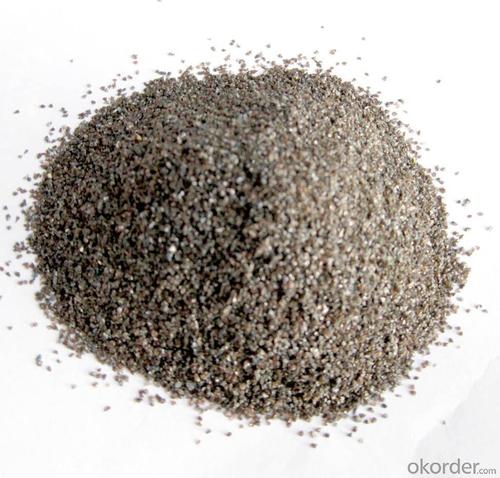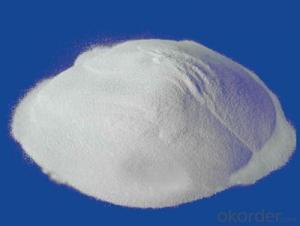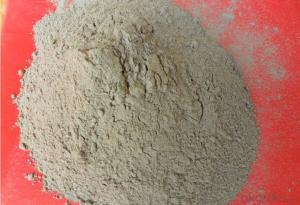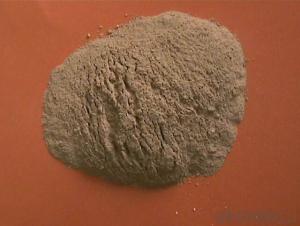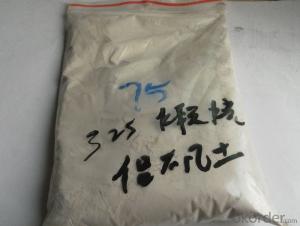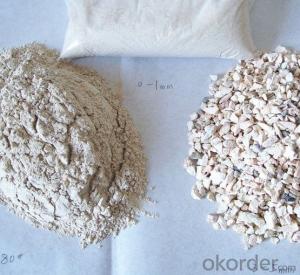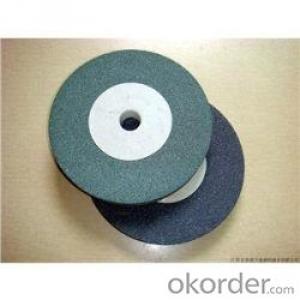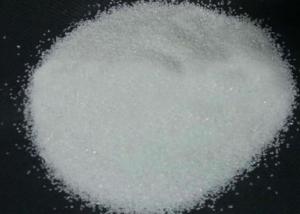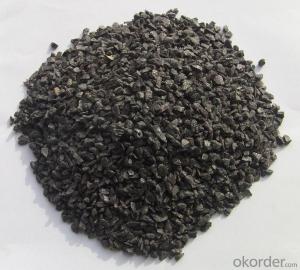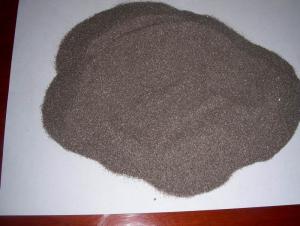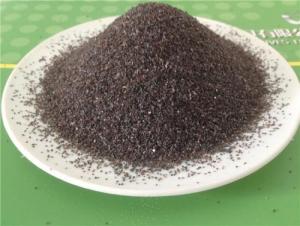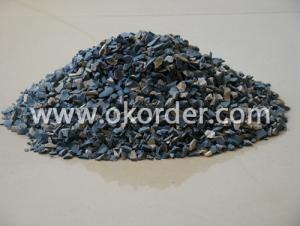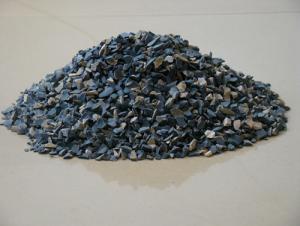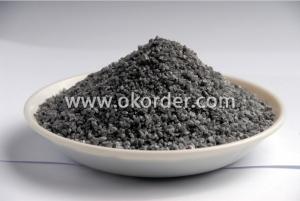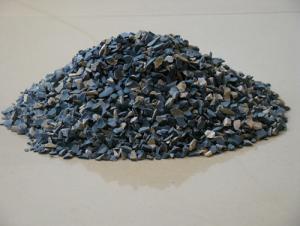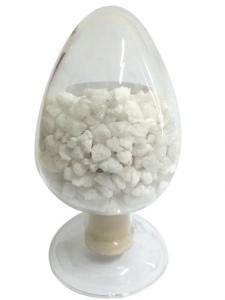Brown Fused Alumina
- Loading Port:
- XINGANG,TIANJIN
- Payment Terms:
- TT or LC
- Min Order Qty:
- 100MT m.t.
- Supply Capability:
- 20000MT/YEAR m.t./month
OKorder Service Pledge
OKorder Financial Service
You Might Also Like
Brown fused alumina:
1.Material: Al2O3
2.Al2O3 Content: 95%min
3. Color: Dark Brown
Quick Details of Brown fused alumina:
Brown fused alumina is made from high quality bauxite by fusing in an electric arc furnace at high temperature. It has good toughness and high hardness. It can be used to make superior refractory products.
Specification of Brown fused alumina:
|
Al2O3 |
95%MIN |
|
TiO2 |
3.50%MAX |
|
SiO2 |
1.5%MAX |
|
Fe2O3 |
0.3%MAX |
Size: 0-1mm, 1-3mm, 3-5mm..... or according to client's request. Also, we can do 220 or 325mesh,etc.
Applications of Brown fused alumina:
Brown fused alumina is used as a raw material in the manufacture of high alumina refractories.
Advantages:
1.We can control the quality and cost due to our strong capacity and cash flow in China .
2. We have strict and mature quality and logistics control on the cargo .
3.As a governmental company, we are reliable.


- Q: Who knows the refractoriness of high temperature lightweight firebricks?
- Refractoriness refractory bricks with different melting points, the melting point is liquid and solid crystal phase at a temperature equilibrium. The vast majority of bricks are made of heterogeneous materials. No fixed melting point, it begins to appear to be melting and becomes complete liquid gradually, solid and liquid coexist over a wide temperature range, fusion and softening of refractory is messured by its performance at high temperature. Therefore, refractoriness is the temperature at which the multiphase reaches a certain degree of softening. Refractoriness is an important technical indicator in evaluating refractory bricks, but it can not be seen as the temperature ceiling. GB / T 7322 "Test Methods for high alumina brick refractoriness" alumina brick refractoriness test standards. refractoriness of some commonly used refractory bricks as follows: 1, clay brick 1610? 1750 ℃ ??2,silicon brick 1690? 1730 ℃ 3, crystalline silica 1730? 1770 ℃ 4, hard paste1750? 1770 ℃ 5, high alumina brickx26gt; 1770? 2000 ℃ 6, magnesite refractory bricksx26gt; 2000 ℃ 7, dolomite refractoryx26gt; 2000 ℃
- Q: What's the texture of refractory for the hearth of reverberatory?furnace? ?
- The long-term usage temperature of ceramic fiber is between 950-1260 degrees.
- Q: What are the physical properties of refractory material?
- The mechanical properties of refractory material include compressive strength, volume density and sclerosing, slag resistance, elastic modulus, thermal shock resistance, oxidation resistance, bibulous rate, fluidity, resilience, bond strength and slump, electrical conductivity, specific heat, heat capacity, the impact strength, linear change, torsional strength, stomatal aperture distribution, resistance to acid, etc. The use performance of refractory material include refractoriness, thermal emissivity, condensation, porosity, coefficient of thermal expansion. Thermal properties of refractory material include thermal conductivity, temperature conductivity, plasticity, the hydration resistance, creep performance. The physical properties of the refractory materials include structure performance, mechanical properties, shear strength, load softening temperature, CO erosion resistance. The structure properties of the refractory materials include porosity, alkali resistance and sintering. The operating performance of refractory material include consistency, tensile strength, the use performance and operating performance, wear resistance, bending strength, thermal properties.
- Q: I want to know what is the slim in the refractory bricks
- lining brick and refractory clay in the teeming ladle; high alumina brick, high alumina lining brick and high alumina refractory mortar can make cement kiln and glass melting furnace in the building materials industry for anti-slide. Taiyuan in Shanxi province is the famous place of origin; hard paste in the refractory clay is used as blast furnace refractory: // b, in agriculture as a fertilizer high alumina clay is also used in oil wells, which generally do not dip in water; accounting for 2/3 of abrasive products in the metallurgy, hard and semi-hard clay can be manufactured as ceramics for daily use. what you said should be slime. High-alumina clay can be resistant to high temperature after calcination! Refractoriness refractory clay refers that the refractoriness is more than 1580 ℃ with greater hardness and specific gravity and high refractoriness. except higher refractoriness, such as aluminum sulfate, the dosage accounts for about 70% of refractories; refractory clay and high alumina fused cast brick are widely distributed in China.
- Q: Is the linear change on reheating the same as heating permanent linear change of refractory material?
- “+”represents expansion. the afterexpansion and aftercontraction after cooled to be at room temperature. The change may significantly damage the masonry of thermal kiln. There are regulations on the linear change on reheating of common refractory material in the national standard. Some physical chemical changes may continue. It is defined as the change from being heated to the specified temperature of refractory material sample. Heat preserving for a while till afte cooling to be at room temperature, then the residual will expand or contract in its length, heat preservation for a while, organization vitrification, the irreversible changes of its length refers to heating the firing refractory to be at high temperature, so as to make the volume of refractory materials expand or contract, due to the influence of uneven temperature or lack of time, otherwise it will cause the deformation of the refractory ball and make this indicator within standard even reach smaller value, so firing control must be strengthened in product production. But it is should not be too high. For refractory materials with same chemical composition, the linear change on reheating is produced in the heating process. Properly increasing sintering temperature and prolonging the holding time is an effective process measures, make its firing inadequate. When subjected to high temperature, it can reduce the thermal shock resistance. Minus sign "-" represents contraction. The permanent line rate refers to heating the fire refractory ball to the specified temperature. Linear change on reheating, also known as residual linear change, is an important indicator to assess the quality of refractory in the long time use. To control the permanent line rate within the standard or reach the minimum value.
- Q: What substitutes are available for high-end refractories in addition to zircon sand?
- Natural ore, synthetic raw materials such as industrial synthetic mullite, etc..
- Q: What's the difference of fire-resistant material's density, specific gravity and bulk specific gravity?
- It usually used to test lightweight refractory. Density can be divided into apparent density (usually called as density) and true density: apparent density includes blow hole inside the sample; Unit weight is using quality to divide volume of sample and specific weight is used to represent liquid.
- Q: Graphite and other carbon materials may be oxidized to CO or CO2 at high temperatures. But why can they be refractories?
- There is no contradiction for this. Any substance can be combustible, but different materials have different ignition points.There are many types of graphite. Pyrolytic graphite has a much lower ignition point. Therefore, as long as it reaches at a certain temperature, it can convert into graphite. Mostly, in practical applications (such as brake pads will add a certain amount of graphite), graphite is required to have refractoriness of below 1000 ℃. Graphite can serves as both the combustible and refractory material. So, it can be used as a fire-resistant and high-temperature-resisrant material because graphite (lamellar graphite) has a ignition point of at least 3000 degrees in an oxygen free condition. The above information is for reference only and is offered by Xin Ruida Graphite Company.
- Q: Can anyone tell me what is a high alumina refractory?
- High alumina refractories: High-alumina refractory products have high refractoriness, compressive strength and refractoriness under load, which are used for building the high-temperature parts of various large blast furnaces, such steelmaking furnace, airheater, electric furnace, rotary?kiln and other thermal equipment.
- Q: What is refractory?
- Refractory is an inorganic nonmetallic material with minimum refractoriness of 1580 ℃. Now, refractory is not defined merely by judging that whether its refractoriness is at above 1580 ℃. Currently, refractory, an inorganic nonmetallic material, are widely used in metallurgy, ceramics, power and other industrial fields.
1. Manufacturer Overview
| Location | Gongyi, China |
| Year Established | 2006 |
| Annual Output Value | US$5 Million - US$10 Million |
| Main Markets | " Mid East;Western Europe;North America" |
| Company Certifications | The Authentication certificate of Quality Management system |
2. Manufacturer Certificates
| a) Certification Name | |
| Range | |
| Reference | |
| Validity Period |
3. Manufacturer Capability
| a) Trade Capacity | |
| Nearest Port | Tianjin |
| Export Percentage | 61% - 70% |
| No.of Employees in Trade Department | 60 People |
| Language Spoken: | English;Chinese; |
| b) Factory Information | |
| Factory Size: | Above 300,00 square meters |
| No. of Production Lines | Above 5 |
| Contract Manufacturing | Design Service Offered |
| Product Price Range | Average |
Send your message to us
Brown Fused Alumina
- Loading Port:
- XINGANG,TIANJIN
- Payment Terms:
- TT or LC
- Min Order Qty:
- 100MT m.t.
- Supply Capability:
- 20000MT/YEAR m.t./month
OKorder Service Pledge
OKorder Financial Service
Similar products
Hot products
Hot Searches
Related keywords



